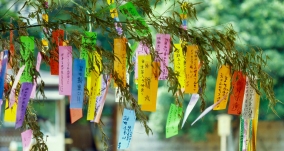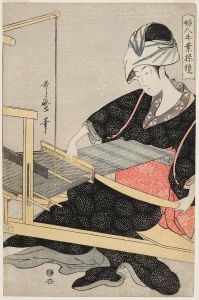 Namekoto no Aya by Yasutoshi Waniko, courtesy Japan Translation Center
Namekoto no Aya by Yasutoshi Waniko, courtesy Japan Translation Center
Tanahata (Tanabata)
Tanahata is a matsuri of the Jomon people, as told by the Wosite documents of Jomon Japan. The Law of Universe is explained in terms of a weaving metaphor. Tanahata is a weaving loom. When weaving, one uses a shuttle to connect horizontal threads with vertical threads. In a similar manner, Ame Cosmos interacts with Tuti Earth, just as wo Male with me Female. The result is Hito, a human being, like you and me. Tanahata connects us with time and space — and with each other. Tanahata is an event that fosters family, global and cosmic relationships.
Tanahata Maturi, Hosi Maturi
In the 7th month of the year, the heat of summer is softening and there is even a breeze tonight. It is the seventh day, the first quarter of the moon, so that the night sky is dark and stars twinkle. The Amanogawa Milky Way is an awesome spectacle. A ceremony is held, the Woto Tanahata no Hosi Maturi. Cotton and hemp are woven, and lotus rice is offered to Amemiwoya, the Cosmic Parent. [Namekoto no Aya, see below.]

Weaving. The Tanahata ceremony was sacred. Weaving was sacred work entrusted to women, for weaving makes the Way of Universe visible in form. The weaving itself represents the unity of Universe and Earth, of man and woman, and their intersection is a person like you and me. This is explained in the Kituyoji teaching recorded in the Wosite document called the Mikasahumi.
Stars. Stars are honored as ancestors. Breath of spirit, breath of life, come from Ame Miwoya. Miwoya is like the pole star, and ancestors are like the stars that rotate around it. Ancestors, too, are a source of life to each one of us. We look up at stars and feel gratitude for the life with which we are blessed. Our Jomon ancestors felt moved at the beautiful sight in the night sky. Their souls connected with ancestors and they started this tradition. Hearts filled with joy and gratitude, they danced.
Time and Space. Another effect of ori weaving of Tanahata is connecting toki-tokoro, time and space. The vertical threads represent time, the horizontal threads space. Tanahata is an observance of time and space. The Tanahata festival was originated by wise ancestors of Wosite Jomon times. Tanahata connects us with time and space, with Universe and Earth, with each other.
“Tanahata is a festival already ancient in Jomon times.”

The Tanahata (Tanabata) star festival of the Weaver was traditionally held on the seventh night of the seventh lunar month. The lunar year did not begin on our January first, so the seventh month is not July but likely to be in our August. Tanabata Matsuri is held in July or August in modern times, and it has become a story of two lovers meeting once a year at the Milky Way. While many think erroneously that the Tanabata Festival is of Continental origin, it was celebrated by Jomonese long before Continental contact. It was not about love relationship, but rather about relationship of humans with others, with ancestors, and with Universe. When you participate in the Tanabata Festival, remember how it originated in Jomon Japan and remember your connections with the stars.
Obon Odori
The dancing of the Jomon Tanahata has spun off into the Bon Odori, the folk dancing a week later when people in their later Buddhist faith welcomed the spirits of deceased ancestors.
Namekoto no Aya
The Wosite passage at the top of this page is from the Jomon-period Mikasafumi document, Namekoto no Aya. It mentions Tanahata in the third line below. A glossary is given in an appendix.
ahumi matu / hume ni yawasite
kaze to nasu / yumi hari ni umu
iu to asa / woto tanahata no
hosi maturi / moti ha miwoya to
iki tama ni / yena no hasuke no
me-wo a-e ha / a-ogi odori te
i o ukuru
Discussion
In the annals of the Wosite documents of Jomon Japan, annual festivals of the first, third, fifth, seventh, and ninth lunar months are mentioned as follows:
1/1 Hatsuhi, New Year’s Day
3/3 Momo no Sekku Peach Festival of Girls Day (Hinamatsuri)
5/5 Aoi Matsuri, Hollyhock Festival of Kyoto
7/7 Tanahata Matsuri, Star Festival
9/9 Kiku-kuri Matsuri, Chrysanthemum-Chestnut Festival
These are all Jomon festivals, kept alive to today.

Jomonese were keen observers of the skies, day and night. When the moon was in its first quarter on the seventh night of the seventh lunar month, they would have seen the summer Milky Way, which they called Amanogawa, the Cosmic River. They would remember the Kituyoji teaching and contemplate toki-tokoro time-space. They could imagine weaving amongst the stars, weaving time and space. And so they called this observance Tanahata Maturi, Hosi Maturi, and we would say Tanabata Festival, Star Festival.
Appendix – Glossary
ahumi, 7th lunar month
hume ni yawasite, the heat is softening
kaze, breeze
yumihari, first quarter of the moon
iu, cotton; asa, hemp
hosi, star
maturi, observance
Miwoya, Cosmic Parent
hasuke, food offering
odori, dance

Weaving on a Loom, by Kitagawa Utamaro 1798
Update 2018.09.12. Matocayamato, another Wosite blogsite, has published a similar post, entitled, Origin of Tanahata and the Origin of Bon Odori.
We have also published a new post on the Tanahata festival of Sendai, August 2018.
***
You must be logged in to post a comment.